 Jack Maguire
Jack MaguireBaxter State Park, in central Maine, closed to summer camping last Friday. While that doesn’t matter to most people, there’s a small group for whom the closure of the park marks the end of an odyssey. Mount Katahdin in Baxter is the northern terminus of the Appalachian Trail, a 2,178-mile footpath that begins on Springer Mountain in Georgia. Every year, roughly a thousand people, called “thru-hikers,” attempt to walk the trail from start to finish. They form a unique subculture brought together by their extraordinary task. They’re all different, and all set out to do it for different reasons, but together they are a community of seekers, bound together by what Joni Mitchell once called “the urge for goin’.”
The extraordinary task began as an extraordinary dream. Benton Mackaye, a brilliant and passionate nature-lover, first put forward the idea for a long trail along the Appalachian Mountains in 1921. People were just beginning to hike recreationally on a large scale, and Mackaye envisioned his path as the crown jewel in America’s budding trail network. He wanted 20th century people to learn to cope with nature, since in his view they were “as helpless [before it] as canaries in a cage.” Guided by the fire of his vision, the trail was completed in 1937.
During the Second World War, no one paid much attention to it. It wasn’t until Second World War veteran Earl V. Shaffer thru-hiked off his post-war depression in 1948 that Mackaye’s dream grew in popularity. A few people tried to follow his lead in the following decades, but as of 1969 only 61 people had managed to finish the entire trail. With the invention of the internal frame backpack in the 1970s, the task became much easier. Thru-hiker numbers began to climb, and they haven’t stopped since. Noteworthy thru-hikers include a six-year-old boy, a blind man, and a grandmother who finished twice wearing Keds on her feet and carrying a duffel bag.
As more people have finished, more and more books have appeared—it seems that the temptation to talk about a 2,000-mile walk is too strong to resist. Though thru-hiking books might look like forgettable exercises in self-indulgence, people who complete the journey agree that it is the experience of a lifetime.
They undertake the hike for all sorts of reasons. The trip doesn’t pay and it certainly isn’t free, with the approximate cost ranging between $4,000 and $7,000. Although it might seem like a pointless, masochistic exercise to some, at last count 1,547 people had taken up the challenge this year.
According to the Appalachian Trail Conservancy (ATC), the trail’s main caretaker, that number is up 10 percent from last year, which they say can be explained in part by unemployment.
“Call it a recession hike. I lost my job and I’m looking for a career change,” said Bird, one of this year’s hikers. “There’s a lot of recession hikers out here.”
Many others are college students taking time off from school, or recent graduates.
“I decided to take a break and get some more experience,” said Pi, a student at Kennesaw State University in Georgia. “As clichéd as it sounds, it’s a journey of self-discovery.”
When I met him, Pi was hiking south with Homer, a heavyset man in his 40s, who was hiking himself back into shape after recovering from an injury.
“The guy I started with decided to quit up in Caratunk, Maine [about 75 miles from Katahdin], and I was hiking by myself for a couple of days,” Homer said, “and then I met [Pi] and we’ve been hiking together ever since, and it’s been great.”
It’s common to see different people with very different motivations hiking together. All-day hiking forces people to get to know each other, for better or for worse. It often allows people who ordinarily wouldn’t talk to each other to connect as friends. Bird, a self-identified liberal, said he got to know an older, conservative Republican whom he probably would never have spoken to if he weren’t on the trail.
“You form a strong, quick bond with people,” said Whippersnap, aka Peter Barr, a thru-hiker and hiking guidebook author from North Carolina.
Not everyone gets along, but most hikers are good to each other. Without fail, every one I spoke to said that their fellow hikers, not the raw physical challenge that lay ahead, kept them going.
“They definitely weren’t all perfectly upright, [but] most of them were really friendly. If you’re a thru-hiker, they’re going to be the nicest person ever to you,” said Jack Maguire, a U3 Management student who thru-hiked from May-August 2009. “There’s a bit of a looking down on people in society out there, because you’re kind of jealous of them.”
The well-established thru-hiker culture has its own vocabulary. “Trail names” are determined informally by other hikers within their first few days on the trail. Maguire’s was “Corporate,” a reference to his chosen field of study. In addition to Homer, Pi, Bird, and Whippersnap, I also met hikers named Tabasco, Transcontinental, Powder, and Karma (so named because of his good luck).
Perhaps thru-hikers bond so well because they’re almost all a little crazy. There are very few “average” people who voluntarily walk every day for five months while they carry their shelter, bed, food, and clothes on their back.
Most hikers carry about 50 pounds: little more than a tent, sleeping bag, change of clothes, cooking gear, and food. They hitchhike to resupply, shower, and relax in towns every 7 to 10 days. Hikers speak especially highly of the hospitality they receive from people along the trail.
“It seems like no matter where you go, you get to a road and you don’t even have to put your thumb out and somebody’s already stopping to pick you up [and] take you into town,” Homer said.
Limited by the space in their packs, hikers lead a life of temporary poverty, which most say changes their perspectives once they return to society.
“You learn to just not need anything, you just give that up,” Maguire said. “I definitely consciously try to use less and just empty my life of material, unneeded things.”
Thru-hikers sign themselves up for a monotonous routine. Though the trail is rich in natural scenery, most of the time hikers are walking through homogeneous forest for hours. Hikers have no choice but to spend most of their days thinking.
“I guess I got kind of sick of the fact that I was thinking of the same things over and over again,” Maguire said. “It kind of made me uneasy, realizing the finitude of my own mind. You’re bo
mbarded with ideas [and] you never experience [that finitude] in our mass media society.”
Physically, the trip requires tremendous endurance and motivation. Maguire and his brother, who hiked the trail at breakneck speed, averaged about 21 miles a day. That’s the same as walking from the Roddick Gates to Mac campus, but with rougher terrain and more up and down. And that’s every day for four months, with no breaks.
As a result, hikers eat like starving bloodhounds. Most hikers are burning 3,000 to 6,000 calories a day by the time they reach cruising pace. Confined to foods both high in calories and easy to pack, hikers do not eat much healthy fare.
“Ramen noodles, pasta sides, peanut butter, Snickers, pop tarts,” Homer said.
Whippersnap, a gaunt, long-bearded, six-foot-tall hiker, told me he got through his days on Spongebob Squarepants, My Little Pony, and Dora the Explorer fruit snacks.
“I thrive on candy all day,” Powder said. “I don’t eat like this at all at home, but out here all I want is Milky Ways.”
With giant needs and a communal culture, thru-hikers are forward when they meet the outside world. They are not self-conscious about their shaggy beards and long hair, and extraordinarily comfortable with their filth.
“You get really used to asking for stuff,” said Maguire.
In my time working at a major waystation for thru-hikers in the White Mountains of New Hampshire, I saw dirty, scarred, smelly men try to cut deals with librarians for Internet time and run impersonation scams in order to score free food.
But hikers have more in common than their neediness—most of them become disciples of nature. From the Scottish crags in the White Mountains and the gentle, rhododendron-covered “balds” in the Great Smokies to the perfect solitude in Maine’s Hundred-Mile Wilderness, the trail visits some of the most breathtaking landscapes in the East. While there is more striking scenery in the Rockies and the Alps, it’s much less accessible there than it is in the Appalachians. Most people who can walk are physically capable of hiking the Appalachian Trail, which is why it’s the most hiked and culturally rich long-distance trail in the country.
Thru-hikers like Maguire certainly no canaries in cages.
“I think the one thing that’s changed me from being out in the woods is that it’s not a scary place,” Maguire said. “You might think you’d get eaten by a rattlesnake or a bear … But the woods is not really that dangerous a place. You hear a little rustle and you think there’s a bear, or you think there’s a rattlesnake underneath the rocks, but eventually you realize that that stuff is not really that prevalent.”
The few who make it through have trouble describing what it’s like to reach the trail’s end-sign after thinking about it every day for months.
“Ecstatic. Euphoria. Euphoria’s probably the right word,” Maguire said. “I mean, you can’t describe it. I look at pictures of that sign [the trail end-marker] and I tear up. I was walking up to Katahdin and thinking, ‘Oh this is just another day hiking,’ [but] I saw the sign and started breaking down. I literally collapsed into the sign.”
While Baxter’s closure was quiet, it is a reason to remember that our segmented and overstimulated culture, there’s still somewhere where our borders, security checkpoints, and suspicions do not exist, and where people challenge themselves to get closer to nature’s riches.








